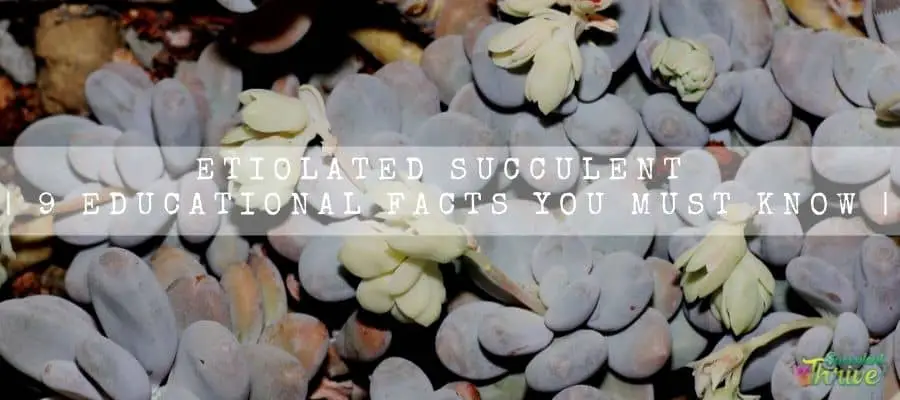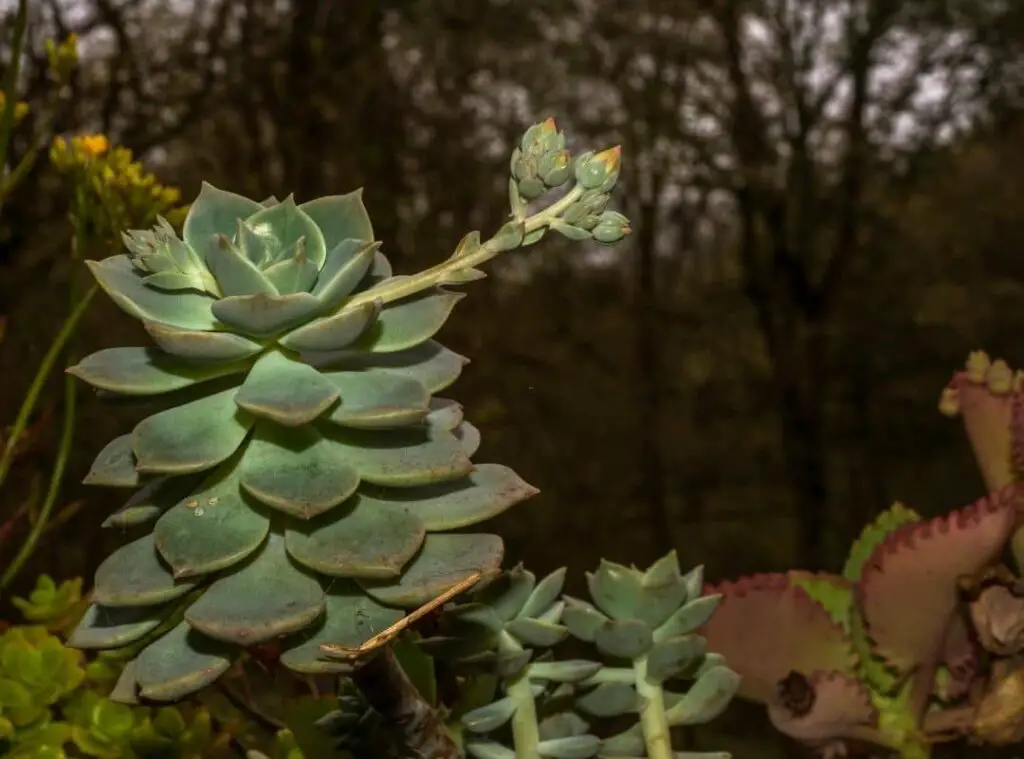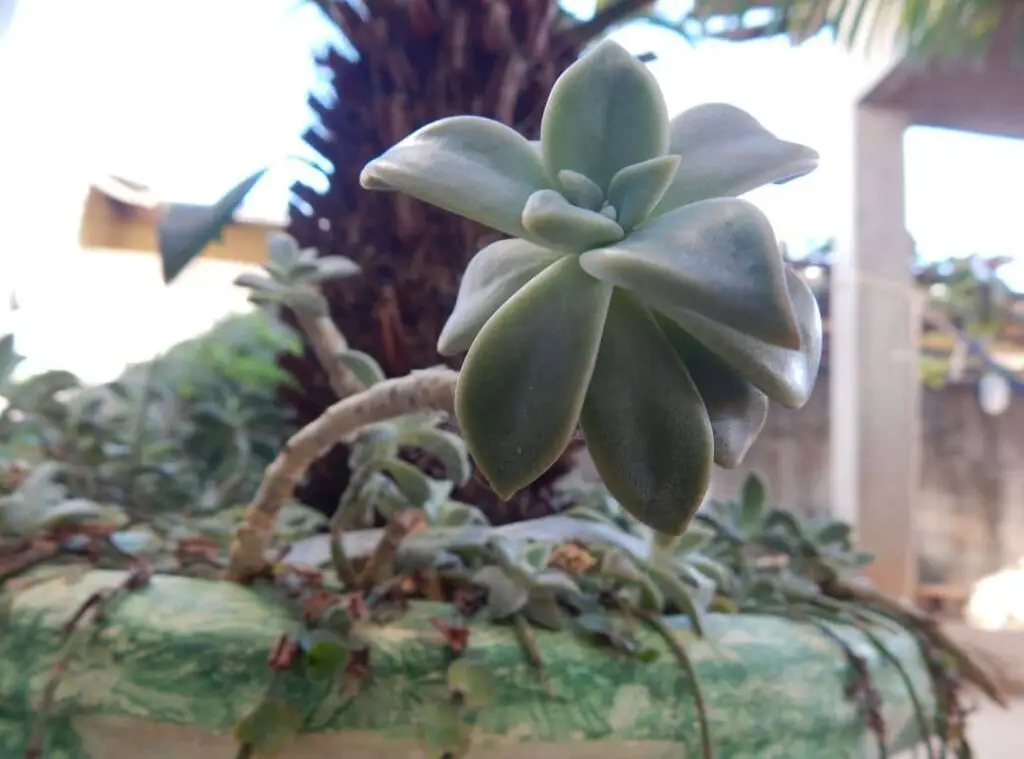Etiolation is quite a common condition among succulents. If you are a succulent grower, you would have come across the term etiolation many times. So if you want to know more about etiolated succulent this article is for you.

What is etiolated succulent meaning?
Etiolation is a pathological condition which is usually gone through by many succulents when they run short of adequate sunlight.
You could identify this condition by their pale colors, stretched or bent structures. You could spot etiolation among many plant species and that is not something which is only limited to succulents.
To explain it further, etiolation is a natural way of responding to lack of sunlight.
When the succulents deprive enough sunlight, they usually tend to bend towards the direction of any light source.
Because of this, you could see the stretched and bent plants. You could spot them usually in pale color and in a weak manner.
That is because the etiolated succulents tend to spend more of their energy to bend towards their lighting source than they usually do.
You could mainly spot this among indoor plants. Obviously as you may understand, the lighting condition these plants receive when growing indoors is very limited.
Plants which require plenty of sunlight would suffer from this condition when you grow them indoors.
If you have grown them under shade or if you have blocked them from sunlight for prolonged periods, those succulents will undoubtedly go through this condition.
On the other hand, etiolation could take place to produce certain varieties of the plant as well.
If I elaborate further on this, you could see how farmers grow white celery and white asparagus with no light and how they form white stalks and spears.
These plants are expensive and further considered as more delicious when compared to their Greek counterparts.
However, if you have an etiolated succulent, it will look goofy and will make them look ugly and unpleasant.
Why do succulents etiolate?
As aforesaid, etiolation takes place as a repercussion of deprivation of adequate sunlight. When this happens, they adjust their growth pattern to reach the maximum sunlight they can find.
On the other hand, succulents need to have adequate sunlight to conduct photosynthesis. It is crucial for them to do this process since that would directly impact on the plant growth.
Further they need to do the photosynthesis process to develop the roots, leaves, stems, and their flowers too.
As such the whole plant life cycle would depend on this food. It is a very crucial process since all life on earth will depend on photosynthesis.
Mankind also consumes the green plants. As such, the whole food chain depends on the sunlight.
So to explain briefly, if the succulents grow without adequate sunlight, they will tend to stretch, curve and get taller to absorb their required sunlight level. As such, light is crucial for succulents’ growth as well as for their survival too.
Is succulent etiolation bad?
Etiolation is not bad and it is not a harmful process for the plant .
When they grow in their natural habitat, they will get adequate sunlight levels and will usually grow vigorously.
So, it is very unlikely that you will spot this condition among the succulents in their natural habitat. You could commonly spot this among the indoor succulents.
Many people find it very unpleasant to look at and you need to make sure that you take all necessary steps to avoid this condition.
However etiolated succulents could live for several years. Having said that, the etiolated succulents would not look attractive like the healthy plants usually do. They will look pale in color and look weak.
When they tend to stretch towards a lighting source, they will end up getting taller and make it look unhealthy.
However, they could still thrive well since they have adjusted naturally to fulfil their sunlight requirement from stretching towards a lighting source.
If you wish, you could prune the etiolated parts of the plants so that it will look nice. Keep in mind to enhance the lighting level though.
If you keep growing the succulents under lowlights for a prolonged period, it will even have a fatal impact on them.

How to identify etiolated succulents
Weak appearance
Normally succulents look vibrant green in color. So, to have that look, it is mandatory that your succulents gain enough sunlight.
When the etiolated succulents run short of adequate sunlight level, they can not produce enough food using their leaves. Consequently your plants will become pale green in color.
Lean to one side
Generally healthy plants would grow in a vertical manner. On the other hand, succulents which grow deprived of sunlight would form in a curved form.
Further you could spot them growing towards the direction of sunlight . This is how the succulents have naturally structured to grow when they run short of enough sunlight for photosynthesis.
Consequently, your succulents would carry a weak stem. In addition to that they will have a gangly look as well.
If you do not shift the etiolated succulents to somewhere where they do not get sufficient sunlight, chances are that the tall growth of the plant would bend towards one direction.
Ultimately that would cause the stem to break. However, when these plants grow in their natural habitat, they tend to break off the stem so that they could start forming new roots given that they get adequate sunlight level. I
If you wish to avoid this situation, I recommend you tie some string with bamboo stakes as that will give support for the plant.
Leaves point downward
If we take succulents such as Echeverias and Sempervivums into consideration, they mainly have fleshy and upright leaves which usually grow in tufts.
So, consider that these plants are light starved, then they would tend to shed their leaves and end up forming pointed downwards.
This would be the initial sign these plants would send out to indicate to you that they are going through Etiolation.
Usually, succulents tend to form their leaves in a downward manner to acquire light to conduct the photosynthesis process. They could increase the leaf’s surface area by doing that.
However, this type of drooping is not permanent, and you could correct it by exposing them to proper sunlight. Usually, you need to expose yourself to sun loving succulents for four hours daily.
Unusual rapid growth and long internodes
Many succulents are renowned as a slow growing set of plants. Having said that, when they grow deprived of sunlight, they usually tend to show rapid growth so that they can reach out for the lightning source faster.
Further when they grow rapidly, they tend to grow longitudinally as well. That will also allow them to reach the lighting source rapidly.
They would direct all their energy to reach this lighting source and grow at a faster rate than what they usually do.
When they grow rapidly, that would create elongated stems which will have only a few leaves. Further those leaves would be widely spaced as well.
The reason to have a smaller number of leaves is because the new leaves cannot form at the same growth rate as the new stem is growing.
As such, they will end up forming only a few leaves. Further this is regarded as a survival antic as the elongated stems could provide more space for light to penetrate the leaves so that they could do the photosynthesis process.
Can you reverse Etiolation in succulents?
Unfortunately, the worst thing when it comes to etiolation is that you cannot fix the etiolated plants no matter what you do.
In other words, if your succulent has become leggy, stretched, and slender they cannot revive as it would remain permanently.
Having said that, if you could identify any early signs of etiolation, you could attend to it before it starts to stretch.
However, despite what you do, you cannot reshape your etiolated succulent to give its former look.
However, you could still use the etiolated plant parts and make more plants by propagating them.
You could simply beheaded to do that. For example, you could try these methods on plants such as Echeverias. On the other hand, you could simply obtain the healthy leaves and use them for propagation as well.
You could get many plants from beheading etiolated succulents as you could replant the cuttings.
You only have to leave a couple of inches from the crown and make a neat cut using a sharp, sterilized knife or scissors.
Once you obtain the cuttings, you need to leave them somewhere where they can dry for a couple of days.
After that, you could plant the beheaded crown in a new pot which you have filled with a well-draining soil mix .I would recommend you chop off any curved plants and replant them in a new fresh soil mix.
You could spot them producing baby plants within a few weeks’ time. By that time, crown and roots will also be established.

What to do with etiolated succulents
You will have to deal with etiolated succulents no matter how experienced you are in succulent gardening.
Specially the fast-growing succulents would become leggy faster.
It will be too late for you to enhance the lighting level as you cannot fix them no matter what you do. However, you could trim them to make them look neat.
Alternatively, you could propagate the etiolated succulents. You could propagate many succulents whilst using healthy leaves, branches or even pups very easily.
When you propagate them, you can always start growing a fresh succulent. It would only take a few weeks’ time .
How to save etiolated succulents
You cannot save an etiolated succulent no matter what you do. In case, if your etiolated succulent is a larger mature plant, you could consider pruning the etiolated plant parts.
That will give them a neat appearance . In addition to that, you should shift the plant to somewhere else where they could gain adequate sunlight.
That will allow you to avoid this recurring condition. If you expose the plants to necessary sunlight levels, they will not stretch out and instead they will grow well vigorously and neatly.
However, if you consider indoor grown succulents, providing enough sunlight would be somewhat challenging.
As such, it is best to grow your beloved succulents by a bright sunny window. I would recommend you grow a succulent variety which could thrive in low light conditions.
Avoid growing succulents which require plenty of sunlight to thrive well. Furthermore, you could consider growing these plants under a grow light so that you could supplement them with additional light.
How to prevent etiolation in succulents
You could avoid the etiolation in succulents if you follow these guidelines.
Reposition your succulents.
Always make sure that you move your succulents to somewhere where they get direct sunlight for some time.
If you have grown them indoors, it is best to place them near a bright sunny window. You need to expose them to bright sunlight for at least four hours per day.
On the other hand, if you have grown them outdoors, you could expose them to full sunlight. However, do not expose them to full sunlight for prolonged periods.
If you do so, it would create sunburns in the plant. You could spot brown edges in the plant, if you had exposed the plant to intense sunlight.
Invest in a grow lamp
You could grow the plants under artificial lights as it would help to perform the photosynthesis process. Consequently, it would help the growth of the plants.
On cloudy days, you could consider growing these plants under grow lamps. When you place the grow lamp, ensure that you locate the grow light vertically. That will allow the plant to grow straight.
Choose different succulents
It would be somewhat challenging to provide ideal growing conditions when growing succulents, particularly providing sufficient lighting conditions could be problematic for someone who lives in low light areas.
In that circumstance, it is best to grow succulents which could thrive in low light levels.
List of succulents which prone to etiolation
- Echeveria.
- Sedum.
- Crassula.
- Sedeveria.
- Graptosedum.
- Graptopetalum.
Conclusions
To wind up, if your beloved succulent is going through an etiolation condition, first do not panic or think your plant is going to perish.
You simply have to apply the aforesaid guidelines to remedy them. If you still think your plants look ugly, you could consider propagating them and making new plants.
Read Next : Graptoveria Blue Pearl Ultimate Care Guide With 3 Propagation Methods
